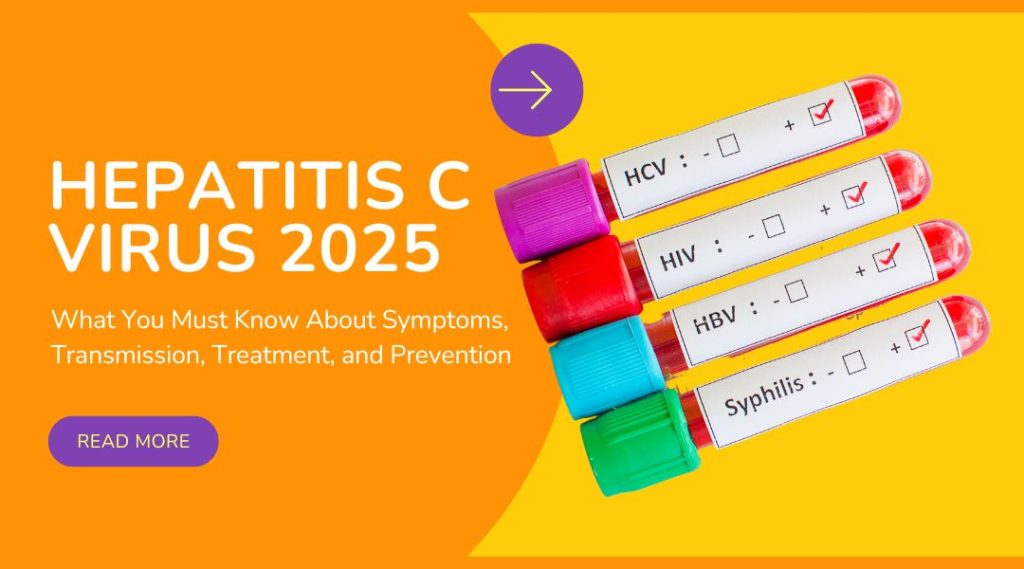
The Hepatitis C virus (HCV) remains one of the most pressing global health concerns in 2025, despite medical advances. With millions affected worldwide, and many unaware of their infection, this silent liver disease continues to pose a serious public health threat. In this article, we will explore everything you need to know about the Hepatitis C virus in 2025, including how it spreads, signs to look out for, current treatments, and how you can prevent infection.
Whether you’re a healthcare professional, someone at risk, or simply someone seeking to protect your health, this comprehensive guide will provide critical, updated insights into managing and avoiding HCV.
What Is Hepatitis C Virus?
Hepatitis C virus is a bloodborne virus that primarily attacks the liver, potentially causing both acute and chronic infections. Over time, untreated HCV can lead to serious complications such as cirrhosis, liver failure, and even liver cancer. While many infected people experience no symptoms in the early stages, the damage continues silently.
How Is Hepatitis C Virus Transmitted?
Hepatitis C spreads through blood-to-blood contact. The most common routes include:
- Sharing needles or syringes (especially among people who inject drugs)
- Receiving contaminated blood transfusions or organ transplants before 1992
- Inadequate sterilization of medical or tattooing equipment
- From mother to baby during childbirth (vertical transmission)
- Less commonly, through sexual contact with an infected person, particularly among MSM (men who have sex with men)
Symptoms of Hepatitis C Virus

Many people with Hepatitis C virus don’t show symptoms until liver damage is advanced. When symptoms appear, they may include:
- Fatigue
- Nausea or poor appetite
- Abdominal discomfort (especially upper right side)
- Dark-colored urine
- Jaundice (yellowing of the skin and eyes)
- Joint pain
Early detection is critical. If you’re at risk, get tested even if you feel healthy.
Who Is at Risk in 2025?
Certain populations face higher risk of HCV exposure. In 2025, these include:
- People who inject drugs or share needles
- Those who received blood transfusions before HCV screening was standard
- Incarcerated individuals
- Healthcare workers exposed to blood
- HIV-positive individuals
- Baby boomers (born between 1945–1965) and people over age 50
Diagnosing Hepatitis C Virus
To confirm a Hepatitis C infection, two main tests are used:
- Antibody Test – Detects past or present exposure.
- RNA Test (PCR) – Confirms active viral infection by measuring HCV genetic material.
Additional tests such as liver function tests, imaging, and biopsy or FibroScan may be done to assess liver damage.
Treatment Options for Hepatitis C Virus in 2025
The great news? Hepatitis C is curable for most people. As of 2025, treatment typically involves:
- Direct-acting antivirals (DAAs) – Pills taken once daily for 8–12 weeks
- Cure rates exceed 95% with minimal side effects
DAA brands vary by region, but newer generics have made treatment more affordable and accessible.
Timely treatment not only clears the virus but also reduces long-term complications and prevents liver damage.
Can Hepatitis C Be Prevented?
Yes – while there is no vaccine for HCV yet, you can take steps to protect yourself:
- Avoid sharing needles, razors, or toothbrushes
- Use sterile equipment for tattoos or piercings
- Practice safer sex, especially with multiple partners or in high-risk groups
- Wear gloves when handling blood or body fluids
- Ensure blood products are screened properly in medical settings
If you’re at ongoing risk, regular screening is the best prevention strategy.
Living with Hepatitis C
If you’ve tested positive for HCV, don’t panic. With modern medicine, a cure is possible and the outlook is good—especially with early diagnosis. Follow these steps:
- Start treatment as soon as recommended by your doctor
- Maintain a healthy liver with diet, exercise, and no alcohol
- Attend follow-up appointments and monitor liver function
- Inform sexual partners if applicable
- Join support groups for emotional well-being
Global Outlook on Hepatitis C Virus in 2025
The World Health Organization has set an ambitious goal to eliminate Hepatitis C as a public health threat by 2030. In 2025, countries are ramping up testing, treatment accessibility, and education campaigns. Innovations such as mobile clinics, point-of-care testing, and integration with HIV services are closing gaps in care—especially in low-resource settings.
Why Awareness in 2025 Still Matters
Despite advances, Hepatitis C virus in 2025 remains underdiagnosed. Stigma, lack of symptoms, and limited testing access contribute to late diagnoses. By promoting awareness, supporting policy changes, and encouraging people to get tested, we can help end the silent epidemic.
References
- World Health Organization (WHO). (2024). Hepatitis C Fact Sheet. Retrieved from: https://www.who.int/news-room/fact-sheets/detail/hepatitis-c
- Centers for Disease Control and Prevention (CDC). (2023). Viral Hepatitis Statistics Report. Retrieved from: https://www.cdc.gov/hepatitis/statistics/index.htm
- Mayo Clinic. (2024). Hepatitis C: Symptoms & Causes. Retrieved from: https://www.mayoclinic.org/diseases-conditions/hepatitis-c/symptoms-causes/syc-20354278
- World Health Organization (WHO). (2024). Global Hepatitis Report 2024. Retrieved from: https://www.who.int/publications/i/item/9789240063720
- American Liver Foundation. (2024). Testing for Hepatitis C. Retrieved from: https://liverfoundation.org/for-patients/about-the-liver/diseases-of-the-liver/hepatitis-c/










